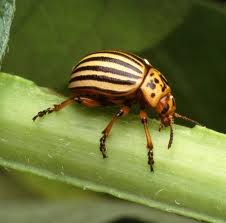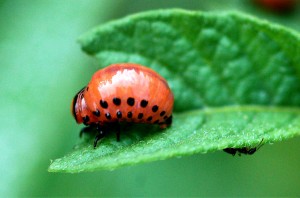The tirade on bad bugs continues…
Mites
The Lowdown: Mite’s microscopic size cause consternation with the naked eye. More frustrating is the fact that if mites go unchecked, they can produce 16 generations in a season! The most common interloper in indoor and outdoor gardens are spider mites. They cause damage by piercing plant cells to feed. The adults spin webs to protect from prey (thus the name). Broad mites can cause more hair pulling thanks to even being invisible with a pair of hand lens. Their feeding can stop a plant’s growth quickly. Flowers can grow abnormally and fall off while leaves curl downward and become brittle. If unchecked, a broadmite infestation can spread around a garden in a matter of days.
Biological Control: Ladybugs and lacewings are for hire through Fifth Season from Nature’s Control. The voracious lacewing larva (aka Aphid Lions) will eat up to 200 mites a day. Plants that repel mites include coriander, dill, and garlic.
Organic Insecticidal Control: Like aphids, one can use Neem Oil as a preventative, but once the infestation is obvious, a more lethal arsenal will be necessary. A sprinkling of diatomaceous earth can pierce the soft body of the mite and cause them to dehydrate. However, the most effective control lately has been Azamax, a neem extract. It acts as an antifeedant, which causes the mites to starve as well as halting their reproduction.
Too bad you can’t see them suffer.
Colorado Potato Beetle
The Lowdown: Lovely in appearance, but ugly in appetite, the Colorado potato beetle targets potatoes, eggplants, and tomatoes. The female loves to lay eggs, sometimes dispersing up to 800 in a season. The eggs (found on the underside of the host plant’s leaves) hatch within 10 days and begin to feed on the leaves (characterized by a skeletonized look) immediately. This wonderful cycle can happen up to three times in a year.
Biological Control: Owning a large chicken farm will certainly work since chickens love the taste of crunchy beetles. If that’s not a possibility, ladybugs and lacewings will eat eggs and larvae. Also, songbirds will gobble up their share. Plants with natural Colorado potato beetle repellents include beans, catnip, marigolds, and garlic.
Human control: Walk around with a bucket of soapy water and handpick the beetles off the plant and into the soap bath. The beetles will be clean, shiny, and dead. Also smash the eggs underneath the host leaf. The carnage will deter future egg laying. Finally, one can even bust out a mini-vacuum and suck the beetles right up.
Organic Insecticidal Control: Colorado potato beetles seem to gain resistance to insecticides over a long period of usage. Right now, the most effective is Spinosad–the nervous system-attacking bacteria found in Monterey Garden Insect Spray. Also a fungus called Beauveria Bassiana (found in Mycotrol, which Fifth Season Asheville will carry soon) releases fungal spores that attack the beetle. Last resort is a rotenone-pyrethrin mix, although its killing discretion is zero in regards to beneficial bugs.
To be continued…




Leave a Reply